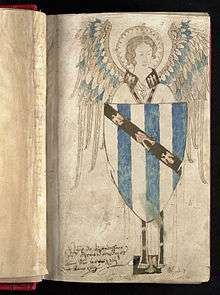John Grandisson
| John Grandisson | |
|---|---|
| Bishop of Exeter | |
 Grandisson's Psalter is now in the British Library | |
| Church | Catholic |
| Appointed | 10 August 1327 |
| Term ended | 16 July 1369 |
| Predecessor | John Godeley |
| Successor | Thomas Brantingham |
| Orders | |
| Consecration | 18 October 1327 |
| Personal details | |
| Died | 16 July 1369 |
| Buried | Exeter Cathedral |
John Grandisson (died 1369) was a medieval Bishop of Exeter. He gave his name to several cultural items that are now in the British Library, the British Museum and the Louvre.
Life
Grandisson was born at Ashperton near Hereford in 1292. His father William, Lord de Grandisson, was a Burgundian in the household of Edmund, Earl of Lancaster, brother of King Edward I of England. He studied theology at the University of Paris, and became a prebendary of Masham in York Minster at the age of 17. He became Archdeacon of Nottingham at 26, then succeeded his younger brother Thomas as a prebendary of Heydore at Lincoln Cathedral.

Grandisson changed his family's coat of arms by substituting a mitre for the normal central eaglet making the arms unique to him. He used this as well as the normal version. Grandisson was the second son of his father so when his elder brother died in 1358 without an heir he became the head of the family.[1]
Grandisson was nominated as bishop on 10 August 1327 and consecrated on 18 October 1327. He died 16 July 1369.[2] Grandisson was buried in the mortuary chapel of St Radegund on the south side of the central doorway of the west front of Exeter Cathedral. His tomb was destroyed during the reign of Elizabeth I.
While bishop, Grandisson outlawed a popular cult that was being promoted by a house of canons in Frithelstock.[3] In addition, in 1335, he founded the original Kings School (Ottery St Mary) (then known as the College of Secular Canons) establishing it as a choir school for eight boys and a Master of Grammar.
Two ivory triptychs and a diptych, inscribed with the emblems of John Grandisson as Bishop of Exeter, were made in England in the 1330s. One of them, known as the John Grandisson Triptych, is a masterpiece of English mediaeval carving.[4] These works of art, which were produced for private devotion, can be found in the British Museum and the Louvre.
In the British Library there is an important psalter known as the Grandisson Psalter as he was one of its notable owners. The psalter records Grandisson's death and records that he left the psalter to royalty.[5]
Citations
- ↑ Proceedings of the Society of Antiquaries of London, Volume 1, p.377, Society of Antiquaries of London
- ↑ Fryde, et al. Handbook of British Chronology p. 246
- ↑ Swanson Religion and Devotion p. 255
- ↑ triptych / religious/ritual equipment, British Museum, retrieved 7 December 2013
- ↑ Records Of The Death Of Bishop John Grandisson, In 'The Grandisson Psalter', British Library retrieved 7 December 2013
References
- Fryde, E. B.; Greenway, D. E.; Porter, S.; Roy, I. (1996). Handbook of British Chronology (Third revised ed.). Cambridge: Cambridge University Press. ISBN 0-521-56350-X.
- Swanson, R. N. (1995). Religion and Devotion in Europe, c. 1215-c. 1515. Cambridge Medieval Textbooks. Cambridge, UK: Cambridge University Press. ISBN 0-521-37950-4.
| Wikimedia Commons has media related to John Grandisson. |
| Catholic Church titles | ||
|---|---|---|
| Preceded by John Godeley |
Bishop of Exeter 1327–1369 |
Succeeded by Thomas Brantingham |